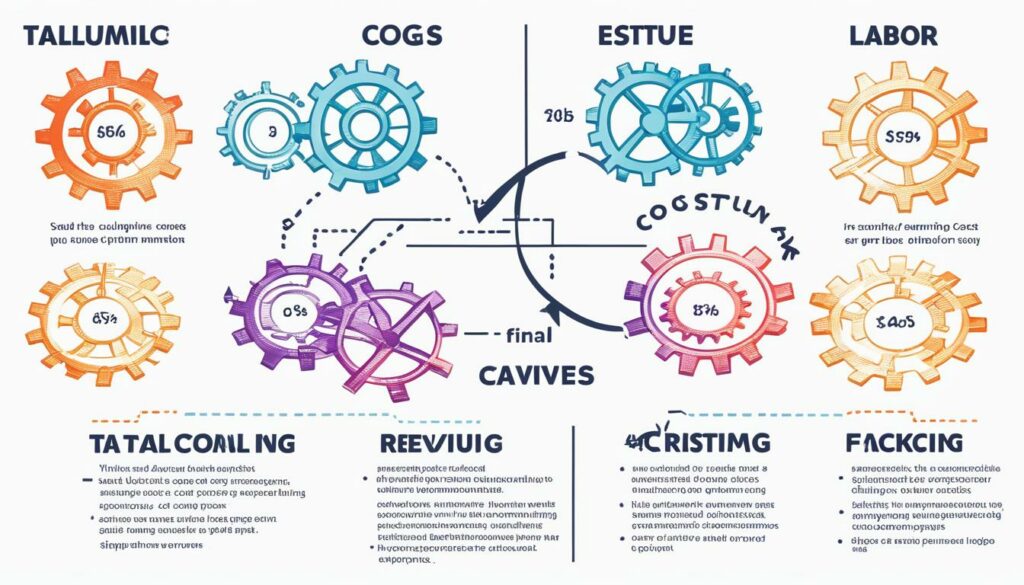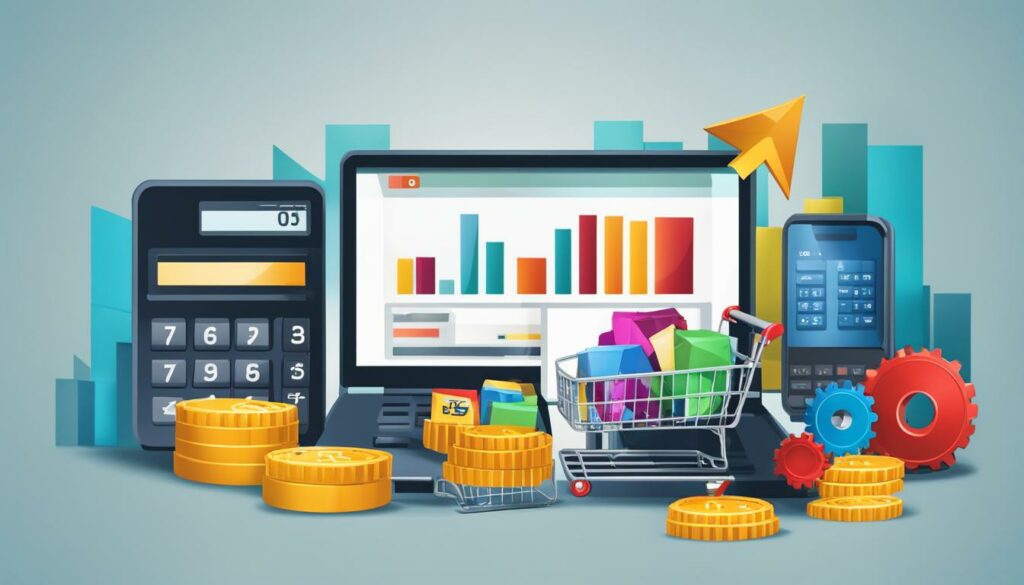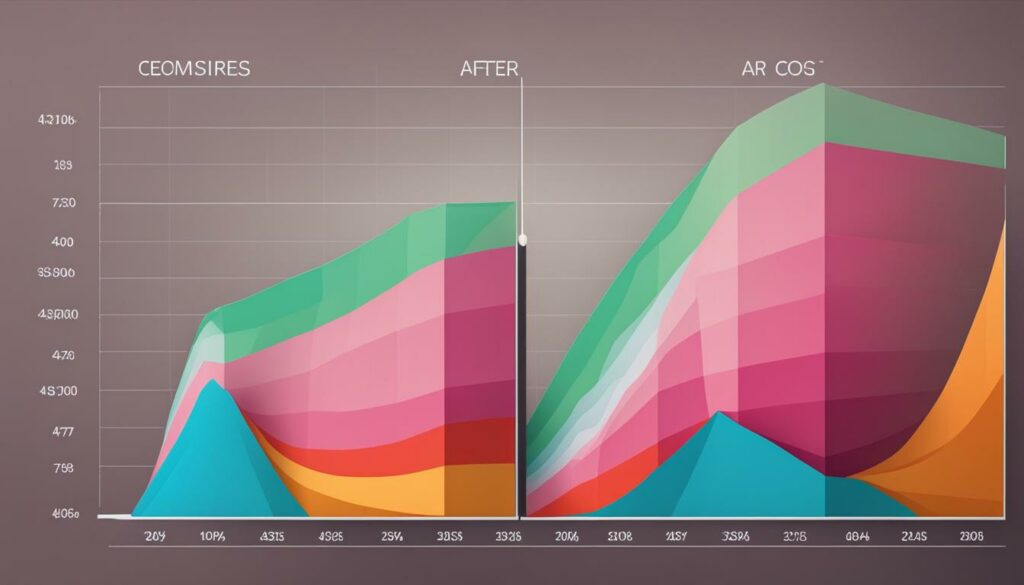Cost of Goods Sold, or COGS, is a fundamental concept in ecommerce that measures the total cost incurred by a business to produce or acquire the products it sells. Understanding COGS is essential for pricing strategies, profitability analysis, and overall financial management.
COGS includes direct expenses such as raw materials and labor directly related to production. However, it excludes indirect costs like marketing, overhead, and shipping. By excluding these overhead costs, COGS provides a clear picture of the expenses directly associated with the production or acquisition of goods.
Accurately calculating COGS is crucial for ecommerce businesses since it directly impacts profit margins and the ability to set competitive prices. By tracking COGS, businesses can make informed decisions about inventory management, pricing, and sourcing strategies.
Key Takeaways
- COGS is the total cost incurred by an ecommerce business to produce or acquire the products it sells.
- It includes direct material and labor expenses but excludes indirect costs like marketing and shipping.
- Accurate calculation of COGS is essential for determining pricing strategies and profitability.
- COGS is calculated by adding starting inventory and purchases, then subtracting the ending inventory.
- Tracking COGS helps businesses make informed decisions about inventory management and sourcing strategies.
How to Calculate COGS for Ecommerce
Calculating the Cost of Goods Sold (COGS) is essential for ecommerce businesses to determine their profitability and make informed decisions. To calculate COGS accurately, you can use the following formula:
Cost of Goods Sold = Starting Inventory + Purchases Made During Period – Ending Inventory
The COGS formula takes into account various factors that contribute to the overall cost of goods sold. Let’s break it down:
- Starting Inventory: This represents the value of the inventory at the beginning of the specified period. It includes the cost of the products available for sale.
- Purchases Made During Period: This includes the costs associated with acquiring or manufacturing additional inventory during the specified period.
- Ending Inventory: This represents the value of the inventory remaining at the end of the specified period. It reflects the cost of the products that were not sold.
By subtracting the ending inventory from the sum of the starting inventory and purchases made during the period, you can determine the total COGS for your ecommerce business.
Accurate COGS calculation is crucial for understanding your gross profit and analyzing the profitability of individual products. It provides valuable insights into the cost structure of your business and helps you make informed decisions about pricing, inventory management, and revenue optimization.
Example:
Let’s take a closer look at a simple example to illustrate the COGS calculation in ecommerce:
| Starting Inventory | Purchases Made During Period | Ending Inventory | Cost of Goods Sold |
|---|---|---|---|
| $10,000 | $5,000 | $6,000 | $9,000 |

In this example, the starting inventory is valued at $10,000, purchases made during the period amount to $5,000, and the ending inventory is valued at $6,000. By applying the COGS formula, the total cost of goods sold is calculated as $9,000.
By accurately calculating your COGS, you can gain insights into your ecommerce business’s financial performance, set competitive prices, and make informed decisions based on real data.
Importance of COGS in Ecommerce Profitability
COGS, or Cost of Goods Sold, is a vital metric for ecommerce profitability. By understanding the cost of goods sold, businesses can accurately set prices that cover expenses and generate profit. Let’s explore the significance of COGS in ecommerce and how it impacts overall profitability.
Effective Pricing Strategies
Knowing the COGS allows ecommerce stores to develop effective pricing strategies. By incorporating the cost of goods sold into pricing decisions, businesses can ensure that their prices not only cover expenses but also generate the desired profit margin. This knowledge helps prevent underpricing or overpricing products, maximizing revenue and profitability.
Informed Marketing Strategies
COGS provides valuable insights for making informed marketing decisions. By understanding the cost of goods sold, ecommerce stores can identify high-margin products that can withstand aggressive marketing campaigns and promotions. On the other hand, products with lower margins may require different marketing approaches. By aligning marketing strategies with the profitability of individual products, businesses can optimize their marketing investments and drive maximum return on investment (ROI).
Accurate Financial Forecasting
Incorporating COGS in financial forecasting enables ecommerce businesses to make accurate revenue projections. By understanding the costs associated with producing or acquiring goods, businesses can estimate future costs and forecast potential profitability. This knowledge helps in making strategic business decisions, such as expanding product offerings or entering new markets.
Compliance with Tax Regulations
Accurate tracking and reporting of COGS is essential for tax compliance. By knowing the cost of goods sold, ecommerce businesses can ensure proper deduction of expenses, minimizing tax liabilities. This compliance not only avoids penalties and legal issues but also contributes to better financial management and cash flow.
Improved Cash Flow Management
Tracking COGS accurately is crucial for effective cash flow management. By understanding the costs associated with producing or acquiring goods, businesses can align their expenses with revenue, ensuring a healthy cash flow. This knowledge helps in budgeting, managing inventory levels, and making strategic purchasing decisions to optimize cash flow.
The importance of COGS in ecommerce profitability cannot be overstated. By incorporating COGS into pricing, marketing, forecasting, and tax compliance, businesses can optimize their profitability, make informed decisions, and drive sustainable growth.

| Benefits of Tracking COGS in Ecommerce | Key Takeaways |
|---|---|
| Effective pricing strategies | Accurate pricing that covers expenses and generates profit |
| Informed marketing strategies | Optimizing marketing investments based on product profitability |
| Accurate financial forecasting | Better decision-making for expansion and market entry |
| Compliance with tax regulations | Minimizing tax liabilities and avoiding penalties |
| Improved cash flow management | Better budgeting and purchasing decisions for optimal cash flow |
Tracking COGS is essential for ecommerce businesses to maximize profitability, make informed decisions, and ensure sustainable growth. By incorporating COGS into various aspects of their operations, businesses can optimize pricing, marketing, forecasting, tax compliance, and cash flow management.
Strategies to Improve COGS in Ecommerce
Managing the Cost of Goods Sold (COGS) is crucial for ecommerce businesses to enhance profitability and maintain a competitive edge. Implementing effective strategies for COGS management and optimization can lead to significant cost savings. Here are some proven strategies to improve COGS in ecommerce:
- Economies of Scale: Take advantage of economies of scale by buying in bulk from suppliers. Bulk purchasing allows you to negotiate better pricing terms and reduce per-unit costs, ultimately improving your COGS.
- Renegotiate Supplier Contracts: Regularly review and renegotiate contracts with suppliers to secure better pricing terms. Building strong relationships with suppliers can lead to cost savings and improved COGS.
- Explore Alternative Suppliers or Manufacturers: Continuously evaluate suppliers and manufacturers to identify opportunities for cost reduction. Exploring alternative suppliers can help you find more competitive pricing and improve your overall COGS.
- Analyze Product Turnover Rates: Regularly assess your product turnover rates to identify underperforming products. Eliminate non-profitable products from your inventory to reduce associated costs and optimize your COGS.
- Streamline Supply Chain Processes: Streamlining your supply chain processes can lead to cost savings and improved efficiency. Automate workflows, eliminate bottlenecks, and optimize inventory management to optimize your COGS.
- Optimize Manufacturing or Production Methods: Review your manufacturing or production methods to identify areas for improvement. By optimizing your processes, you can achieve cost efficiencies and lower your COGS.
Example of Renegotiating Supplier Contracts
“Renegotiating supplier contracts allowed me to secure better pricing terms and significantly reduce our COGS. By establishing a strong relationship with our suppliers and showcasing our long-term commitment, we were able to negotiate more favorable terms, resulting in cost savings of up to 15%.”
– Jane Johnson, CEO of XYZ Ecommerce
COGS Reduction Impact
| Strategy | Impact |
|---|---|
| Economies of Scale | Reduced per-unit costs, leading to overall COGS reduction |
| Renegotiating Supplier Contracts | Improved pricing terms and significant cost savings |
| Exploring Alternative Suppliers or Manufacturers | Increased competition and better pricing options for COGS optimization |
| Analyzing Product Turnover Rates | Eliminating non-profitable products and reducing associated costs |
| Streamlining Supply Chain Processes | Improved efficiency and cost savings in inventory management |
| Optimizing Manufacturing or Production Methods | Lower production costs and improved COGS management |
Implementing these strategies can enable ecommerce businesses to optimize their COGS and improve profitability. By effectively managing COGS, you can enhance your competitive position in the market and achieve long-term success.

Customer Behavior and COGS in Ecommerce
Customer behavior plays a significant role in shaping the pricing strategies of ecommerce businesses. Understanding how customers perceive the value of products and their pricing preferences can help organizations optimize their cost of goods sold (COGS) and maximize profitability. By aligning pricing with customer behavior, ecommerce stores can effectively manage their COGS and achieve sustainable growth.
One important aspect of customer behavior is their willingness to pay for a product. Some customers may be willing to pay a premium price for products they perceive as high-quality or unique, while others may prioritize lower prices. The ability to identify these customer segments and tailor pricing strategies accordingly can directly impact COGS.
For products with higher profit margins, targeted marketing campaigns can be implemented to attract customers who place value on quality or exclusivity. By highlighting the unique features and benefits of these products, ecommerce stores can increase the perceived value and justify a higher price point. This targeted approach allows businesses to maximize revenue and profitability while keeping COGS in check.
On the other hand, products with lower profit margins may require a different marketing approach. Ecommerce stores can focus on volume-based strategies, offering competitive prices and promotions to attract a larger customer base. By leveraging economies of scale and driving higher sales volumes, businesses can offset lower profit margins and manage their COGS effectively.
“Understanding the relationship between customer behavior and pricing is crucial for optimizing COGS in ecommerce. By aligning pricing with customer preferences and willingness to pay, businesses can strike a balance between profitability and customer satisfaction.”
By continuously analyzing customer behavior and its impact on pricing strategy, ecommerce businesses can make data-driven decisions to optimize their COGS. Implementing pricing experiments, conducting surveys, and regularly reviewing sales data can provide valuable insights into customer behavior and inform strategic pricing decisions.
Examples
Let’s look at two examples to illustrate how customer behavior impacts COGS and pricing strategy:
| Product Category | Customer Behavior | Pricing Strategy | COGS Impact |
|---|---|---|---|
| High-end fashion | Customers perceive high-quality and exclusivity as key value drivers. | Premium pricing and targeted marketing campaigns to create brand allure. | Higher profit margins offsetting higher COGS. |
| Everyday essentials | Customers prioritize affordability and competitive pricing. | Volume-based pricing strategy and promotions to attract a larger customer base. | Lower profit margins mitigated by higher sales volumes. |
COGS and Its Relation to Other Metrics in Ecommerce
When it comes to the financial performance of an ecommerce business, understanding the relationship between COGS and other key metrics is crucial. COGS, or Cost of Goods Sold, serves as a fundamental component in assessing profitability and making informed decisions. Let’s explore how COGS is closely linked to several other essential metrics in the ecommerce landscape.
Gross Profit and Gross Profit Margin
Gross profit is a vital metric that indicates the profitability of each sale and is calculated by subtracting COGS from revenue. By analyzing the gross profit margin, which is calculated as a percentage, ecommerce businesses can assess the efficiency and effectiveness of their pricing strategies. A higher gross profit margin implies that the business has a greater ability to cover its operating expenses and generate profit.
Net Profit and Return on Investment (ROI)
COGS also influences the net profit of an ecommerce business. Net profit is the final profitability metric that takes into account all expenses, including overhead costs, marketing expenses, and COGS. By managing COGS effectively, businesses can increase their net profit and optimize their return on investment. This allows for better allocation of resources and facilitates growth and expansion in the ever-competitive ecommerce landscape.
Cash Flow Management
COGS has a significant impact on the cash flow of an ecommerce business. By accurately tracking and managing COGS, businesses can streamline their financial operations and ensure better cash flow management. Effective COGS management enables businesses to allocate resources strategically, optimize inventory levels, and maintain a healthy financial position.
By examining the relationship between COGS and these critical metrics, ecommerce businesses can gain valuable insights into their financial performance. Through data analysis and careful evaluation, businesses can make informed decisions to improve profitability, optimize pricing strategies, and enhance overall operational efficiency.

Challenges and Considerations in Managing COGS for Ecommerce
Managing the Cost of Goods Sold (COGS) in the ecommerce industry presents unique challenges that businesses must navigate to ensure profitability and success. One of the key challenges is the accurate tracking and recording of inventory, especially as ecommerce stores grow and their product catalogs become more complex. Without effective inventory management systems in place, businesses may encounter difficulties in tracking COGS, leading to inaccurate calculations and potential financial implications.
Integrating COGS data with accounting software is crucial for efficient management. By synchronizing inventory data with financial records, businesses can track COGS more accurately and make informed decisions regarding pricing, forecasting, and profitability analysis. However, the diverse range of ecommerce platforms available may not always provide robust COGS reporting capabilities. In such cases, businesses may need to rely on external tools or manual calculations to ensure accurate COGS tracking and reporting.
Accurate COGS management is essential to avoid negative implications on pricing, profitability, and tax compliance. Inaccurate COGS calculations can result in pricing decisions that do not adequately cover costs, leading to reduced profit margins or even losses. Moreover, incorrect COGS data can also impact tax calculations and compliance, potentially triggering tax penalties or audits. It is therefore imperative for ecommerce businesses to stay vigilant, implement effective inventory management systems, and diligently calculate COGS to ensure accurate financial reporting and informed decision-making.
To overcome these challenges, ecommerce businesses should consider investing in inventory management software specifically designed for their industry. These software solutions can streamline inventory tracking and provide real-time data on COGS, helping businesses make accurate pricing decisions, optimize profit margins, and ensure tax compliance. Implementing robust inventory management processes and regularly auditing COGS calculations can also help businesses identify and address any discrepancies or inefficiencies, ultimately enhancing overall profitability and success.
FAQ
What is Cost of Goods Sold (COGS) in Ecommerce?
Cost of Goods Sold (COGS) is the total cost incurred by an ecommerce business to produce or acquire the products it sells. It includes direct material and labor expenses related to production, but excludes indirect costs like overhead, marketing, and shipping.
How to Calculate COGS for Ecommerce?
COGS can be calculated using the formula: Cost of Goods Sold = Starting Inventory + Purchases Made During Period – Ending Inventory. Starting inventory represents the value of inventory at the beginning of the period, while purchases include the costs of acquiring or manufacturing additional inventory. Ending inventory is the value of inventory remaining at the end of the period.
What is the Importance of COGS in Ecommerce Profitability?
COGS plays a crucial role in ecommerce profitability. It helps businesses set prices that cover their costs and generate profit. By knowing the cost of goods sold, ecommerce stores can make informed decisions about pricing, marketing strategies, and forecasting.
What Are Strategies to Improve COGS in Ecommerce?
Ecommerce businesses can implement various strategies to improve their COGS. Some strategies include taking advantage of economies of scale by buying in bulk, renegotiating contracts with suppliers for better pricing, and exploring alternative suppliers or manufacturers. Analyzing product turnover rates and eliminating non-profitable products can also help reduce COGS.
How Does Customer Behavior Affect COGS in Ecommerce?
Customer behavior plays a significant role in the pricing strategies that ecommerce businesses adopt. Understanding the relationship between customer perceptions of value and product pricing can help businesses optimize their COGS. By aligning pricing with customer preferences and willingness to pay, ecommerce stores can maximize profitability and manage their COGS effectively.
How Does COGS Relate to Other Metrics in Ecommerce?
COGS is closely linked to several other important metrics in ecommerce. It is a component of gross profit, which is calculated by subtracting COGS from revenue. Gross profit margin, calculated as a percentage, indicates the profitability of each sale. COGS also influences other key performance indicators (KPIs) such as net profit, return on investment (ROI), and cash flow.
What Are the Challenges and Considerations in Managing COGS for Ecommerce?
Managing COGS in ecommerce comes with its own set of challenges. Some common challenges include accurate tracking and recording of inventory, especially as businesses grow and their catalogs become more complex. Integrating COGS data with accounting software is crucial for effective management. Additionally, ecommerce platforms may not provide robust COGS reporting, requiring businesses to rely on external tools or manual calculations.
